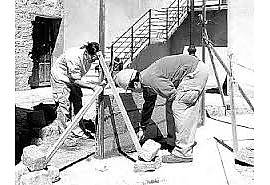- Spain



'Escuela Taller' (Training School) in Úbeda, Spain

© “IU considera inadmisible el desmantelamiento de las Escuelas Taller y propone nuevas acciones formativas remuneradas para la juventud” by Alberto Bustos, izquierda unida valladolid is licensed under CC BY-SA 2.0 FR
1. ICH domains
Traditional craftsmanship
2. Short description
The Escuela Taller or Training School in Úbeda, Spain, was created to help address the growing shortage of heritage building and landscape skills using traditional crafsmanship within the local labour market. The model provides a basis for replication in other places where a lack of traditional building skills is widespread, and this has potentially serious implications for the ongoing repair and regeneration of cultural heritage.
In the Escuela Taller, specialised training is provided in a range of handicraft skills related to the rehabilitation and conservation of heritage buildings. The programme aims not only to provide professional qualifications for young people and to integrate them successfully into the labour market, but also to continue the transmission of traditional handicraft skills and occupations. In doing so, the training school creates opportunities for youth employment and improves the quality of restoration of historic buildings and public spaces.
Importantly, the Escuela Taller promotes teaching techniques whereby training in practical skills is associated with heritage education. This approach raises students’ awareness and appreciation of the value of tangible and intangible heritage. The school demonstrates the personal and community benefits derived from investing in both heritage and youth.
Further information:
In the report, ‘Getting cultural heritage to work for Europe’, the European Commission’s Horizon 2020 Expert Group on Cultural Heritage outlines future directions for EU Research and Innovation Policy in Cultural Heritage until 2020, specifically mentioning the Training School in Úbeda:
Page 15: https://www.kowi.de/Portaldata/2/Resources/horizon2020/coop/H2020-Report-Expert-Group-Cultural-Heritage.pdf
A direct link to the project from the Úbeda municipal site:
http://www.ubeda.es/ubeda/extranet/noticiasdetalle?al_idioma_pk=1&inicio=1&al_men_pk=&as_ruta_men_pk=&al_suscripcion=0&al_not_pk=376&al_tipo_pk=1 (in Spanish)
Page 15: https://issuu.com/laranatalini/docs/getting_cultural_heritage_work_for_
Page 85: http://www.historic-towns.org/wp-content/uploads/2018/09/Inherit-complete-doc-final-version-pdf-Layout-1-1.pdf
3. Link with sustainable development
The Úbeda training school contributes to achieving SDG 4 of providing quality education while also integrating intangible cultural heritage into the content of the educational programme. The program falls under the larger umbrella of Spain’s Culture and Development Strategy, meant to foster the cultural opportunities and capacities of people and communities as substantial elements in sustainable human development, and as such contributes to SDG 8 as a means of decent work for all. Part of the school’s strategy involves supporting heritage conservation skills, restoration, preservation and enhancement, for tangible and intangible heritage, and promoting the contribution that these multi-sector efforts can make to sustainable development, thus also contributing to SDG 9 fostering innovation while promoting inclusive and sustainable industrialisation and building resilient infrastructure.
4. Questions for reflection
In what ways can active community involvement be achieved in the planning and delivery of formal education programmes on ICH? Who decides on which skills/crafts are to be included in the curriculum, and what is the basis for inclusion?
How can safeguarding strengthen the ICH but yet balance out the danger of mass production on the bearers of ICH?
Would over-commercialisation and de-contextualisation of the ICH be an issue here as it gets more popular, and if so, how can stakeholders act against it?